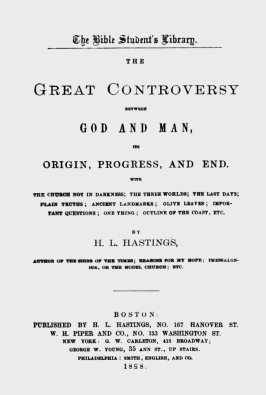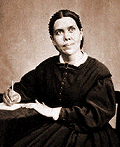"Top 7 Myths: #7: Received the Great Controversy in Vision"
Charge
This charge comes to us from Dirk Anderson's web
site. The idea behind this one is that Mrs. White's March 14, 1858, vision about the "Great Controversy"
and subsequent book were inspired not by God,
but by a book written by first-day Adventist H. L. Hastings. We quote:
As the story goes, on March 14, 1858, Ellen White had her famous
Lovett's Grove vision about "The Great Controversy". Interestingly
enough, a mere four days later, on March 18, 1858, a review of
Hastings' Great Controversy appeared in James White's Review magazine!
In order to appear in the March 18 issues [sic.] of the Review, the book
had to have been purchased and read earlier in the year. It quickly
becomes obvious the Whites were familiar with Hasting's book prior
to Mrs. White's vision. . . . In the review of Hastings'
Great Controversy that appeared in the Review article
the author (most likely James White, but possibly Uriah Smith) . . . . |
[Note: The above wording, posted on Dirk's site since at least 2000, has been
slightly changed since we posted this page in late 2003. The revised wording corrects
the mistake made about who the author of the Review article was, and hints that
James White may not have been around when Hastings' book arrived in Battle Creek.]
 |
 |
| Hastings' Book |
|
Initial Observations
The Titles
This charge appeared quite promising, but unfortunately, someone
forgot to read closely the title of Hastings' book. According to the picture of the cover as
found on Dirk's site, which we post here for your examination, the
title can be clearly seen as reading: The Great Controversy Between God and Man.
In contrast, Mrs.
White's book is entitled, The Great Controversy Between Christ and His Angels,
and Satan and His Angels. If you're trying to
convince an Adventist that he's wrong, this difference is anything but slight.
When Adventists speak of the "Great Controversy" theme,
they are talking about a war between Christ and Satan, a war that
Satan started because he was jealous of Christ's position and authority as the Son
of God in heaven. This theme can be found in much of Mrs. White's writings, as is evident
in the title chosen for her book. But Hastings' "Controversy" is between God and man,
not between Christ and Satan.
Analysis
A Common Phrase
We decided to peruse the writings of other Christians to see how popular the phrase "great controversy" has been.
Our quick search resulted in 19 references from 14 authors, including Augustine, Melancthon, Arminius, Flavel,
Matthew Henry, John Wesley, and Albert Barnes. See the entire list of quotes and references
here.
Whenever considering the question of plagiarism, especially when the charge relies on the similarity of but a few
words, one must consider the possibility that both sources were merely using phrasing common in society at that time.
In such cases, by today's standards, no credit need be given.
In all the above references we found, not one referred to a "great controversy" between Christ and Satan.
Thus far it appears that this specific theme was unique to Mrs. White.
Where Was James White?
As Dirk appears to know, Uriah Smith was the editor of the Review at this point,
not James White. It is therefore fairly certain that Uriah, not James, wrote
the unsigned book review in question. And that being so, one must simply ask the question,
Was James White in town when the book arrived at the Review office?
According to the picture of the cover as found on Dirk's site,
Hastings' book bears the date of 1858. The window of opportunity for James to see
this book prior to March 14, the date of the vision,
is therefore small.
In the February 18 issue, James said:
| IT is our design to be at the Conference at Green Spring the 26th, and
to meet in Conference with the brethren at Gilboa, March 6th and 7th.
We may spend three or four weeks in Ohio. JAMES WHITE. |
We'll assume that he was in Battle Creek when he submitted this notice for publication,
though that was not always the case when such notices were published.
Hastings' preface to his book contains the following dateline:
| Rochester, N.Y., January,
1858. |
When in January? Who knows. But the point is that Hastings' did not complete his
book until sometime in January, after which it was printed, after which it was bound,
after which it was shipped from Rochester, NY, to Battle Creek, MI.
Now if it reached
Battle Creek before that last week of February, when James White departed
for Green Springs, OH, and if Uriah Smith showed it to him, then this allegation
would have some possibility of being true.
But with such big "if's,"
this charge could never stand up in a court of law as is.
More evidence is necessary before a condemnation can be rendered.
When was the book completed in Rochester? When did the book arrive at Battle Creek?
Did anyone travel with the book from Battle Creek to Ohio
while the Whites were in Ohio? Did anyone in Ohio already have the book, and show it
to James there? Just about the only thing we know for certain at this point
is that Uriah did not call James on his cell phone to tell him all about Hastings' book.
 |
Evidence requested
8,055 days ago
on Oct. 28, 2003. |
| Initial Reply |
|
We look forward to the opportunity to see solid evidence that James White
saw this book prior to his departure the last week of February, or saw it at any time prior to March 14.
Hopefully we will not have to wait too long to receive such evidence from the presumed author
of the web page in question.
Further Analysis
Dirk makes his case:
| It quickly becomes obvious the Whites were familiar with Hasting's book prior to Mrs. White's
vision. This becomes abundantly clear when one does a chapter-by-chapter comparison between
the two books. Although the words are often different, and Mrs. White added many doctrines
specific to the Seventh-day Adventist church, it can be seen that Mrs. White took the topics
and structure directly from Hastings' Great Controversy in developing her own Great
Controversy. The following quotes are shown to illustrate how Mrs. White copied topics,
structure, and even plagiarized a few direct quotes from Hastings without giving him credit:
|
Imagine our surprise to not find one example of plagiarism out of the
22 comparisons Dirk then presents. True, both books said that Christ was "blindfolded" at His humiliation, and that
people said to Him, "Hail, King of the Jews." Yet all this shows is that both Hastings and Mrs. White
were incorporating into their books actual wording found in the Holy Scriptures.
Such is definitely not plagiarism.
Many of the alleged similarities in thought
appear to result from the fact that both books are commenting on various Bible stories.
Any book covering the major stories of the Bible will appear similar in topics and order of topics
to any other book that covers the same ground, even though neither author has heard of the other's work.
This brings us to a rather peculiar contradiction we found in the material on this page.
To bolster his claim of plagiarism, Dirk, or whoever wrote this page, quotes twice from Don McAdams,
a gentleman who has spent a lot of time researching these questions. However, in another page on Dirk's site,
one written by Walter Rea, Rea quotes McAdams as saying:
|
The books are very similar, but a careful comparison does not support the idea that
Ellen White's book is based on Hastings'. The book may have stimulated her thinking,
and suggested many ideas, but she did not have it open before her when she wrote her volume:
she emphasizes some points he ignores and presents detail not found in his book.
|
It should be pointed out that Rea disagrees with such an assessment, and gives
8 comparisons of his own, of which two of the better ones are:
|
Hastings |
Ellen White |
|
violence fills the earth |
And the earth was filled with violence |
|
Moved with this "fear" he seeks to escape. . . . he "prepared
an ark for the saving of himself and house." |
moved with fear, prepared an ark to the saving of his house;
|
|
All this shows is that both Hastings and Mrs. White were quoting from Genesis 6:11 and Heb. 11:7.
In fact, since Mrs. White followed these verses more closely than Hastings, we can know with certianty
that she got her words from Scripture, not Hastings, in these two examples.
Specific Conclusions
- Hastings' book had a different focus than Mrs. White's Great Controversy vision.
- Thus far it is entirely speculative to say that James White saw Hastings' book prior to March 14, 1858.
- Even the very authorities that the critics cite admit that Ellen White did not base her book on Hastings' book.
General Conclusions
There seem to be some confusion among those critical of Mrs. White as to what is plagiarism and what is not.
It would be well for them to thoroughly research the topic, for it sounds rather peculiar to suggest that
Mrs. White plagiarized simply because she quoted the same Scriptures
someone else used when commenting on the same Bible stories.
Moreover, it is commonly known that Matthew, Mark, and Luke are quite similar in wording and topics.
Is Dirk suggesting that Luke was a fraud simply because he used the words
of Matthew when writing down the divine thoughts God gave him? There are indeed people out there who would say such.
How then can Dirk consistently uphold the authority of God's Holy Word without demolishing it with
the same weapons that he uses to destroy Ellen White?
We feel that Dirk's readership deserves to know up front his position on the authority of Scripture,
and how he avoids destroying it along with Ellen White.
Give Us Your Opinion
| Did Hastings' book "inspire" Mrs. White's vision? |
|
|
|


